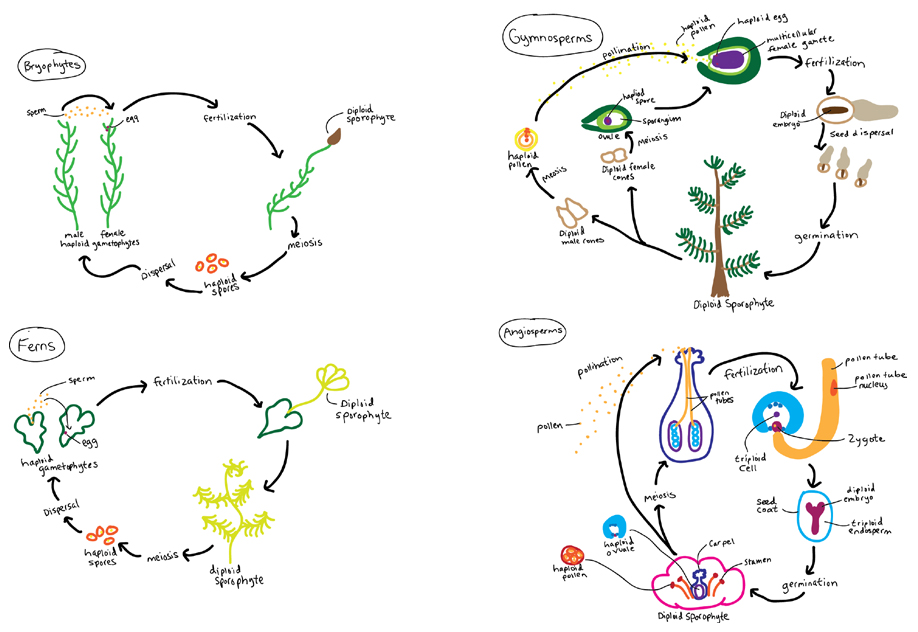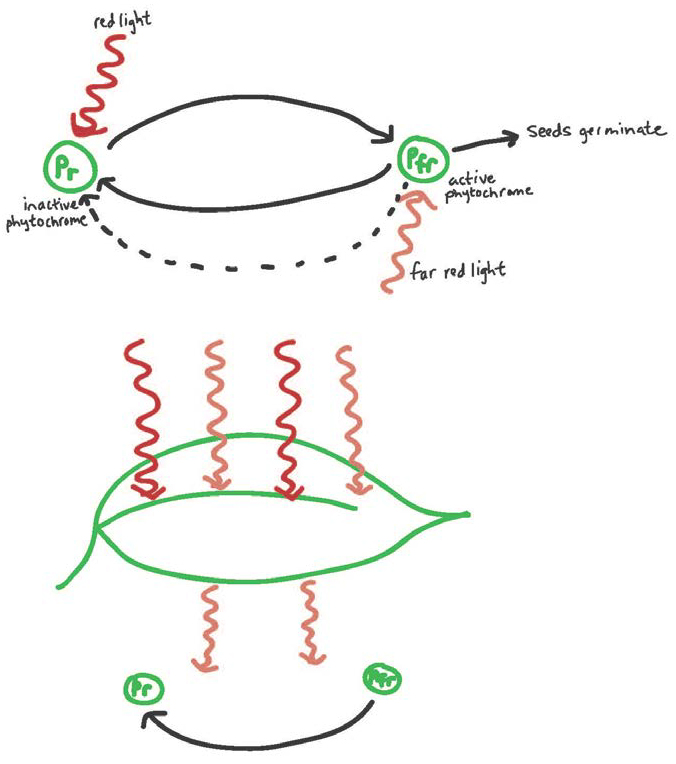CHAPTER SUMMARY
30.1 THE PLANT LIFE CYCLE EVOLVED IN WAYS THAT ENHANCE THE ABILITY TO UNITE GAMETES AND DISPERSE OFFSPRING ON LAND.
- The life cycle of the algal sister groups of land plants has one multicellular haploid generation.
- The life cycle of land plants is characterized by an alternation of haploid and diploid generations, one generation specialized for fertilization and the other for dispersal.
- Gametes are haploid cells produced by mitosis from cells in the multicellular haploid generation, which is referred to as the gametophyte.
- Spores are haploid cells produced by meiosis from the multicellular diploid generation, which is referred to as the sporophyte generation.
- Bryophytes have a free-living haploid gametophyte that makes gametes and a dependent diploid sporophyte that makes spores that are released into the air.
- In spore-dispersing vascular plants, both the gametophyte generation and the sporophyte generation can survive on their own.
- Bryophytes and spore-dispersing vascular plants rely for fertilization on swimming sperm released into the environment.
- A trend in the evolution of plants is the progressive reduction in size and independence of the gametophyte and the increasing role of the sporophyte.
- Pollen is the male gametophyte that develops within the spore wall, and so can be transported through the air.
- The female gametophyte of seed plants is retained and nourished by the sporophyte. The female gametophyte, together with the surrounding layers of protective tissues, is called an ovule. Ovules, when fertilized, develop into seeds.
- Pollination is the transport of pollen to the ovule, where fertilization takes place.
- Seeds contain the diploid embryo, a seed coat, and, in gymnosperms, nourishment in the form of the female gametophyte.
30.2 ANGIOSPERMS (FLOWERING PLANTS) ATTRACT AND REWARD ANIMAL POLLINATORS, AND THEY PROVIDE RESOURCES FOR SEEDS ONLY AFTER FERTILIZATION.
- The pollen and ovules of gymnosperms are produced in separate structures, whereas the pollen and ovules of angiosperms often form in one structure, the flower.
- Flowers consist of four whorls of organs: ovule-bearing carpels, pollen-producing staments, petals, and sepals.
- Many flowers attract animals because they provide a reward, such as food, shelter, or chemicals. Animals, in turn, transfer pollen.
- Flowering plants have genetic and structural mechanisms to prevent self-fertilization.
- Double fertilization, which is unique to angiosperms, is the formation of a diploid zygote and triploid endosperm. The endosperm nourishes the embryo that develops from the zygote.
- The fertilization of an ovule triggers the development of the ovary wall into a fruit, a structure that enhances seed dispersal.
30.3 PLANTS HAVE SENSORY SYSTEMS THAT CONTROL THE TIMING OF FLOWERING AND SEED GERMINATION.
- Many plants are photoperiodic, meaning that their flowering is controlled by the amount of daylight.
- Plants measure day length through an interaction between photoreceptors and a gene regulated by an internal clock.
- Vernalization is a requirement that a plant be exposed to prolonged cold temperatures before flowering can be induced.
- Dormant seeds must be triggered to germinate by appropriate environmental signals.
- Some seeds will not germinate unless they have been previously exposed to a prolonged cold period.
- Phytochrome is a protein photoreceptor that allows plants to determine the amount of red versus far-red light. Because light filtered through leaves has lower levels of red wavelengths, phytochrome allows plants to detect the presence of plants overhead.
- Plant reproduction is central to agriculture because it allows plant breeders to create new genotypes.
30.4 MANY PLANTS ALSO REPRODUCE ASEXUALLY.
- Vegetative reproduction produces plants that are genetically identical to the parent plant.
- Vegetative reproduction can occur when a plant spreads horizontally and develops new upright shoots.
Self-Assessment Question 1
Explain how the evolution of alternation of generations is an adaptation for reproduction on land.
Show Model Answer
Model Answer:
Alternation of generations is the basic plant life cycle in which a haploid gametophyte stage and a diploid sporophyte stage follow one after the other. Alternation of generations has allowed plants to thrive on land because the haploid spores produced by the sporophyte can disperse over a large distance without the need for water.
Self-Assessment Question 2
Diagram the relationship between the sporophyte and gametophyte generations in bryophytes, ferns, gymnosperms, and angiosperms. Show the relative sizes and physical interactions (if any) of the two generations.
Show Model Answer
Model Answer:

Self-Assessment Question 3
Explain how the organs in the different whorls of angiosperm flowers interact to promote fertilization.
Show Model Answer
Model Answer:
The four whorls develop into carpels, stamens, petals, and sepals. A stamen has a structure called an anther that contains several sporangia in which pollen is produced. Once the anther splits open and exposes the pollen, the pollen can then be carried by animals or the wind to the sticky stigma of the carpels. Here the pollen germinates and extends its pollen tube down through the style to reach the ovule in the ovary of the carpel.
The often colorful petals attract pollinators. The sepals do not play a direct role in fertilization; they protect the flower during its development.
Self-Assessment Question 4
Contrast the investments that angiosperms and gymnosperms make and the structures that they produce to enhance pollination.
Show Model Answer
Model Answer:
Gymnosperm pollen and ovules are produced in separate structures, and pollen is carried to the female structure by the wind. Angiosperms often produce pollen and ovules in one structure, the flower. Some angiosperms take advantage of the wind to disperse their pollen, but more common is the use of animal pollinators.
Because the sites of pollen and ovule formation are near each other in a flower, a pollinator can deliver pollen to one plant and take up pollen to carry to another plant in a single visit. Pollen is captured on the sticky or feathery stigma at the top of the ovary-containing carpel. Many angiosperms invest in rewards like nectar or attractants like scent to lure pollinators.
Self-Assessment Question 5
Diagram the structure of a mature angiosperm and a mature gymnosperm seed, indicating the ploidy (1n, 2n, 3n) of each tissue and its role in seed development and germination.
Show Model Answer
Model Answer:

Self-Assessment Question 6
Explain why a short-day plant that germinates in the spring will not flower until late summer and why a long-day plant that germinates at the end of summer will not flower until late the following spring.
Show Model Answer
Model Answer:
The expression of a gene that allows plants to flower varies with a circadian rhythm, controlled by an internal clock. The protein expressed by the gene is stabilized by light, which is sensed by the plants’ photoreceptors. Enough of the protein accumulates only when there is overlap between high rates of gene expression and stabilization of the protein by light.
Self-Assessment Question 7
Diagram how the amount of red versus far-red light allows plants to determine if they are in the open or in the forest understory.
Show Model Answer
Model Answer:

Self-Assessment Question 8
Describe how vernalization can have an effect in cells that were not formed at the time of the cold treatment.
Show Model Answer
Model Answer:
Vernalization is the process in plants in which flowering can be induced only if the plant has experienced a prolonged period of cold temperatures. The mechanism acts through chromatin remodeling, turning on or off genes. Chromatin remodeling is stable through mitotic divisions, explaining why newly formed parts of a plant “remember” developmental events.